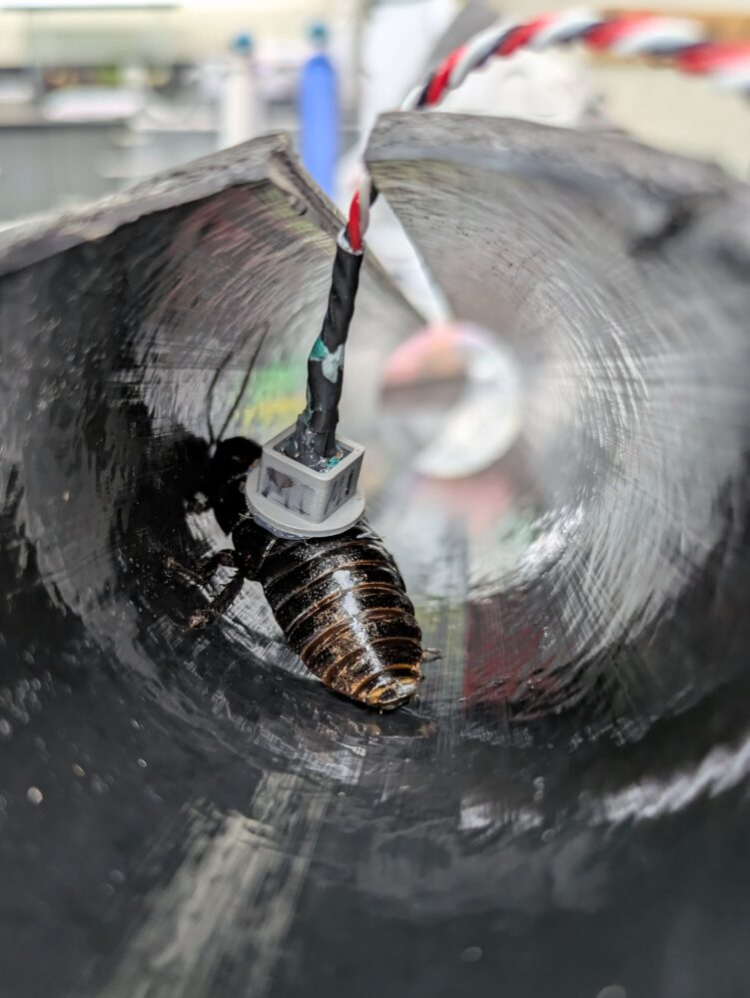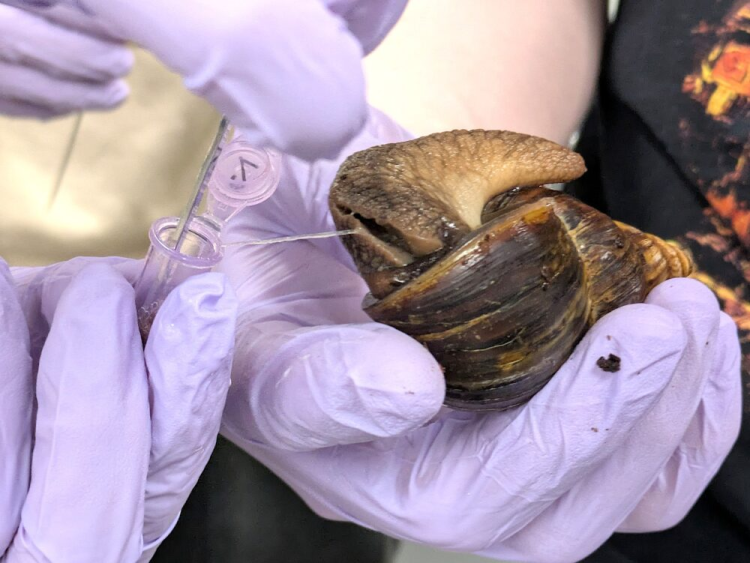Cold-blooded creatures are on the move in a University of Guelph laboratory. Madagascar hissing cockroaches and giant African land snails slink along surfaces, leaving behind questions that zoology undergrads must uncover for their final projects:
How does pitch-black darkness affect the cockroaches' diets? How does exercise impact their heart rates? Does their slime have antibacterial properties?
Few curiosities are off limits in Experimental Comparative Animal Physiology, a fourth-year zoology course led by Drs. Andy Turko and Sarah Schorno in the College of Biological Science. The first half of this course focuses on the scientific method, analysis of scientific literature and science communication, with students conducting pre-planned experiments using a diversity of animal models.
But the lessons stick more deeply this year, as Turko and Schorno decide to do something different this winter semester - they set their students loose in the lab. Now, undergrads take the second half of the course to ask novel questions and complete independent projects, with few guardrails from their instructors.

"One of the most important things a science graduate should leave with is an understanding of the scientific method," says Turko, professor in the Department of Integrative Biology. "And there's no better way to teach science than by actually doing science."
"I was impressed by how much they just took their projects and ran with them," says Schorno, course coordinator and instructor.
U of G students lead their own hands-on projects
On "team cockroach," one group designs a 3D-printed backpack, fitted with sensors to test how physical exertion impacts the cockroaches' heart rates.

U of G students design 3D-printed backpacks to measure heart rates of cockroaches
Students glue their machine onto the insects' backs and watch their subjects move across a ramp, tilting the ramp at different angles and recording the resulting heart rate levels.
With open circulatory systems that are not used to transport oxygen, Turko teaches, these cockroaches are perfect specimens to learn why heart rates differ so much between vertebrates and insects.
That lesson is driven home much more tangibly as students learn how to craft their 3D designs so that their experiments work as intended.
"I walk down the hall, put the 3D printer on a cart and bring it into the lab," Turko says. "Students are printing backpacks 30 minutes later."
Across the room, another group finds surprising results.
On "team snail," one group of students investigates the antibacterial properties of the creatures' slime. With help from Department of Molecular and Cellular Biology undergraduate teaching coordinators Catrien Bouwman and Amanda Van der Vinne, and using equipment from the Tiny Earth Microbiome Lab, students use growth plates to see how five common bacterial pathogens respond to the slime and what grows on the slime itself. Then, they witness something unexpected.
"Bacteria in the slime prevented the growth of all sorts of common pathogens," says Turko, "including those that resist many common antibiotics. To my knowledge, no one has ever shown that."
The goal of an undergraduate course is rarely to generate new research knowledge. However, Turko says, the potential significance of that finding ranges from understanding the unique defenses of invasive species to providing a novel source of antibiotics, much needed in an age of antimicrobial resistance.
The results might even find their way to a peer-reviewed research study, with one of these students interested in pursuing the secrets of the slime in graduate school.

Students collect mucus from snails to determine antimicrobial properties
Other projects are similarly innovative.
Students pair a respirometer with a strobe light to measure the impact of stress on the cockroaches' metabolism. Others give peanut butter to see how the cockroaches might adjust to high-fat diets in the wild.
One group even uses Twitch, the platform primarily used to live-stream video games, to solve a logistical problem - how do they observe their snails remotely when class is not in session?
Interested in how periods of light and darkness influence the snails' movements, these students suggest that exposing the snails to bright light might be a cheap way to keep these nocturnal creatures out of the crop fields they disrupt. To observe them overnight, the students set up a camera in a light-controlled chamber to monitor activity levels of their snails.
Their project draws even a few strangers, who log into the Twitch stream to watch the research in live action - somewhere beyond the U of G community.
Curiosity thrives in zoology capstone experience
"We didn't have a plan for these students," Turko says. "They did whatever they were curious about. We believed this curiosity was what was going to make them put in the time, do the reading and actually be engaged with what they were doing."
"We didn't restrict the lab time for when they could run their experiments and some were much more intensive than others," says Schorno. "They showed amazing work ethic and initiative in getting this done in such a short timeframe from conception to set up and data gathering."
Turko and Schorno's philosophy on experiential learning led the course to be redesigned toward independent research. Now it is a compelling capstone experience for honours thesis zoology majors, on par with ocean equivalents like marine biology and oceanography.
They thank the teaching staff at U of G for making it possible.
"We're very fortunate here to have staff who are so keen, talented and generous with their time so that we could actually pull these experiments off," Turko says.
Setting his sights on next year, Turko says that there are plenty of learnings to be carried forward. Studying freshwater stream fishes at risk, he uses the course to instill students with a small sense of his day-to-day projects - using science to address key challenges that prevent the effective conservation of different species.
"Next year, we'll do the independent research earlier," Turko says, "and let students chase their dreams sooner."












